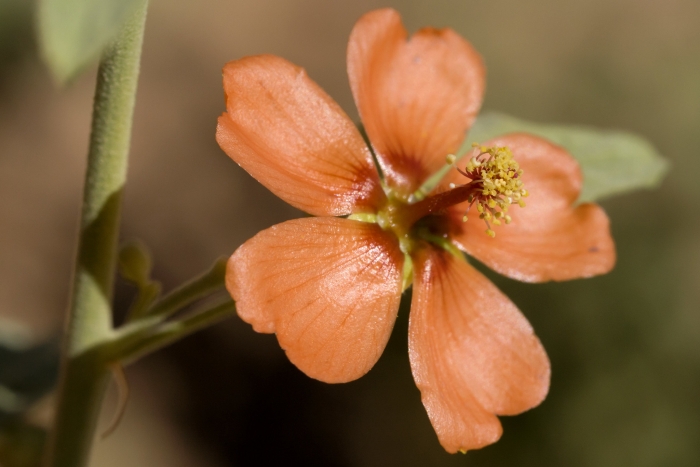Gray Globemallow
(Sphaeralcea incana)
Gray Globemallow (Sphaeralcea incana)
/
/

Patrick Alexander
CC0
Image By:
Patrick Alexander
Recorded By:
Copyright:
CC0
Copyright Notice:
Photo by: Patrick Alexander | License Type: CC0 | License URL: http://creativecommons.org/publicdomain/zero/1.0/deed.en | Uploader: Josve05a | Publisher: Wikimedia Commons |






















Estimated Native Range
Summary
Sphaeralcea incana, commonly known as Gray Globemallow, is a deciduous perennial subshrub or herb that is native to arid environments such as arroyos, plains, and deserts, as well as chaparral regions in the Southwestern USA and Northwestern Mexico. It typically grows to a height of 3 feet (0.9 meters) and spreads to about 2 feet (0.6 meters) wide. The plant is characterized by its gray-green foliage, which is covered in dense, short scurfy hairs, giving it a distinctive texture. The flowers are a brilliant orange and are particularly showy, blooming from June through October. In some years, following a wet winter, the plant can produce extensive displays, creating ’carpets of flowers’ that are highly attractive to pollinators.
Gray Globemallow is valued for its drought tolerance and its ability to thrive in full sun with minimal water, making it an excellent choice for water-conserving landscapes, native plant gardens, and wildlife habitats. It is also used in natural landscaping projects and is available from specialty plant nurseries. The plant’s flowers provide a valuable nectar source for native bees and butterflies, enhancing local biodiversity. While it prefers well-drained soils, it is adaptable to various soil types as long as they are not waterlogged. Gardeners should be aware that Sphaeralcea incana can spread by self-seeding, which may require management in smaller garden settings.CC BY-SA 4.0
Gray Globemallow is valued for its drought tolerance and its ability to thrive in full sun with minimal water, making it an excellent choice for water-conserving landscapes, native plant gardens, and wildlife habitats. It is also used in natural landscaping projects and is available from specialty plant nurseries. The plant’s flowers provide a valuable nectar source for native bees and butterflies, enhancing local biodiversity. While it prefers well-drained soils, it is adaptable to various soil types as long as they are not waterlogged. Gardeners should be aware that Sphaeralcea incana can spread by self-seeding, which may require management in smaller garden settings.CC BY-SA 4.0
Plant Description
- Plant Type: Subshrub, Herb
- Height: 3-4 feet
- Width: 1-2 feet
- Growth Rate: Moderate
- Flower Color: Orange
- Flowering Season: Summer, Fall
- Leaf Retention: Deciduous
Growth Requirements
- Sun: Full Sun
- Water: Low, Medium
- Drainage: Fast, Medium
Common Uses
Bank Stabilization, Bee Garden, Bird Garden, Drought Tolerant, Groundcover, Hummingbird Garden, Low Maintenance, Potted Plant, Showy Flowers
Natural Habitat
Arid environments such as arroyos, plains, and deserts, as well as chaparral regions in the Southwestern USA and Northwestern Mexico
Other Names
Common Names: Soft Globemallow, Soft Globe-Mallow
Scientific Names: , Sphaeralcea incana, Sphaeralcea incana var. cuneata, Sphaeralcea incana subsp. cuneata, Sphaeralcea incana subsp. incana, Sphaeroma incanum,
GBIF Accepted Name: Sphaeralcea incana Torr. ex A.Gray